Cat Rambo's Blog, page 4
March 28, 2023
Announcing The 1st Wayward Wormhole Intensive Writing Workshop

The Rambo Academy for Wayward Writers, fantasy and science fiction’s premiere online learning center, announces a new venture for 2023 – the Wayward Wormhole, an intensive writing workshop with some of the industry’s top teachers.
The inaugural Wayward Wormhole will run November 1 to 21, 2023 at Castle de Llaés, in the municipality of Gurb, Spain. Look northward from the castle to see the Pyrenees and southward to see the rolling hills of Catalonia. Ten students and four instructors will spend three weeks here writing and critiquing, while a virtual component allows other students to experience Wormhole-Light.
The Rambo Academy for Wayward Writers has been in existence for twelve years, serving hundreds of students who have gone on to win awards, honors, and accolades, including Nebula, Hugo, and World Fantasy Awards. “I attended Clarion West, and have taught at multiple workshops now,” says Academy founder Cat Rambo. “While others have delivered the gold standard, I want to stretch to the platinum level and deliver an amazing workshop in an equally amazing setting.”
The Wayward Wormhole instructors for 2023 are Tobias Buckell, Ann Leckie, Sarah Pinsker, and Cat Rambo, all seasoned instructors of the Rambo Academy for Wayward Writers. Details on how to apply for the workshop, costs, and other information can be found at http://www.catrambo.com/waywardwormhole
March 20, 2023
Guest Post: Confessions of a Reluctant Writing Gamer by Janet K. Smith
Writing games. I avoided them for years because I was short on time, not ideas. Once I lifted my head from my page, I realized my focus was all wrong. This one-hour-a-week “game” held incredible lessons I couldn’t get anywhere else.
So why the reluctance? That’s the easy part. Take a first-born, type-A personality with a novel in its final draft, multiple short stories out on rejection—oops, I mean submission, numerous other half-written stories, and a second novel that’s itching for a conclusion, then disrupt that work with “games” full of nonsensical sentence prompts, and odd pictures, and you’ll find a non-believer who prefers to focus on “real” work.
I’d occasionally pop into the session, but more often than not, I’d log out as soon as I heard it was a writing game and not the story discussion or feral writing time I’d expected. If I had a deadline to meet, anything with the word “play” was dismissed automatically. Who had time for play? For five and a half years, fun writing seemed like an oxymoron.
 I remember getting a rush of rejections, one after another, on stories I’d poured my soul into. I wasn’t hitting the right notes somewhere, and it was time to figure out where. Yet I joined writing games with a casual attitude, logging less than a hundred words per challenge. I had good ideas, but I’d edit my sentences as I went, placing structure and grammar above word count. Others did four or five times my number of words in the ten to fifteen minutes per prompt, and even though I knew the writing gems appeared in unfettered prose, I couldn’t stop fixing things. It wasn’t satisfying, and soon I was back to one or two sessions a month.
I remember getting a rush of rejections, one after another, on stories I’d poured my soul into. I wasn’t hitting the right notes somewhere, and it was time to figure out where. Yet I joined writing games with a casual attitude, logging less than a hundred words per challenge. I had good ideas, but I’d edit my sentences as I went, placing structure and grammar above word count. Others did four or five times my number of words in the ten to fifteen minutes per prompt, and even though I knew the writing gems appeared in unfettered prose, I couldn’t stop fixing things. It wasn’t satisfying, and soon I was back to one or two sessions a month.
For the next few years, I’d join a session if I was bored or had spare time. I still considered writing games an extra, as if writing for fun was a waste of time. Professional writers repeatedly told me, “Don’t correct your work. Let it flow.” Sure, I told them, but I didn’t mean it. I hadn’t found that crucial key that added value to prompt writing. Then one session, a brave reader shared an emotionally beautiful piece of prose inspired by a prompt I’d done little with. Hearing someone else achieve so much using the same prompt in the same length of time was inspiring. I wanted that and realized I’d handicapped myself by focusing on my own writing when I should have been listening to others.
Once my focus shifted, writing games became more than “fun.” The following week I dug in and wrote 193 words, still correcting as I wrote, but less than before. I read to the group, and people waved in appreciation. Then a more seasoned writer read her work. Her character came alive in the first sentence, and she’d given her listeners a strong sense of place, so when the plot kicked in, and things got dark, I pictured the surroundings as if I were there. I instantly saw where my work fell short. I’d drafted a plot outline—a summation. I wanted those primordial elements of life on the page, and her example showed me the way. Her skills, added to all the other things I’d done to improve my craft, lit a spark of understanding, and my writing changed at that moment.
With my resistance gone, I attended each writing-games session with a “challenge accepted” attitude, and my interest leaped from a three-four to an eight-nine. The key wasn’t in the task or the prompt but in hearing what others did with it—how they started their piece, the word choices, phrasing, character description (an area where I truly suck), and other elements handled in a way I envied. I was playing, but in a way that made sense to me.
One of the regulars at writing games is so good at drilling down on a sentence. She doesn’t just write of things normally associated with the contents in the sentence; she lists the things it’s not, then builds support for what it is. For example, the prompt: “Desire is no light thing.” She wrote that a dead body is heavier than a living one, but it should be lighter since the dead no longer have desires, and desires keep people alive—grounded with a gravity that can’t be ignored. I mean, wow! Then there’s another regular who creates the best descriptions and another who launches into crazy, off-kilter prose that shoves my logical mind aside. Taking the creative leap with him is exhilarating.
The range and variety of works are fun, and not in a candy-crush time-sucking way, but fun the way reading is fun. Everyone constructs their stories differently, and whether they focus on setting, character, plot, or a beautiful meld of all three, the creativity and flex of craft are always impressive. There are still prompts that don’t tickle my muse. Take “what are we but ten minds? this is sent with love. this paper has gone far.” I was blank on this one with a capital “B,” but others in the group produced some great pieces, and listening to the “what and how” of their prose was as important to my growth as a writer as plying my own skills to the task.
Looking back, I realized I needed those first years to understand that I was creative and could pull a story from the air using a prompt. But when I wanted more, writing games offered that too.
Beauty lies in the impulsive writing, the understanding and skill brought by the other players, and the option to listen while others read their work. Of course, reading is always optional, but it’s a supportive, safe place to share when your muse strikes. No one gives critiques here, and getting those double-hand waves for a piece that delights you feels pretty nice after writing in isolation these last few years. It’s also a great place to try new techniques, viewpoints, or styles, like poetry or second person.
After six months, I can honestly say my writing has improved. It has miles to go, but that’s the fun of it. I don’t want a skill-level ceiling. Last week, I wrote 247 words in twelve minutes—my new record. I had a character with a personality twist, a plot arc, a strong antagonist, and a good ending. I drafted a story. In twelve minutes. It needs fleshing out, and there’s no setting, but I saw people gasp when the story took an unexpected turn, so I know the bones are there.
The coolest part? I didn’t get there on my own.
Join Cat Rambo and friends on Wednesdays at 11:00 a.m. Pacific Time for Writing Games.
If you’re an author or other fantasy and science fiction creative, and want to do a guest blog post, please check out the guest blog post guidelines. Or if you’re looking for community from other F&SF writers, sign up for the Rambo Academy for Wayward Writers Critclub!
March 14, 2023
Guest Post: Juliet Kemp On Writing as Play
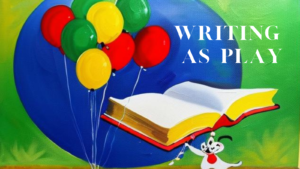 I admit to being a sucker for the Ticky Box. Which is to say, I am perhaps excessively motivated by having Lists and Ticking Things Off Them. I like setting goals for myself, and I’m good at breaking those goals down into smaller steps, rewarding myself for them, all that sort of self-management stuff. I’m keen to write, to write more, to write better; so I use my goals to manage all those things. And as far as it goes (and for as long as it works), that’s great.
I admit to being a sucker for the Ticky Box. Which is to say, I am perhaps excessively motivated by having Lists and Ticking Things Off Them. I like setting goals for myself, and I’m good at breaking those goals down into smaller steps, rewarding myself for them, all that sort of self-management stuff. I’m keen to write, to write more, to write better; so I use my goals to manage all those things. And as far as it goes (and for as long as it works), that’s great.
The trouble is that sometimes all those lists and goals instead get me stuck in fear: fear of not meeting the goals, fear of not improving ‘enough’, fear of not writing the book of my glorious imaginings. (Spoiler: I am never going to write ‘the book of my glorious imaginings’, because my glorious imaginings are a cloud of inchoate vibes, not a collection of real actual words, and a book is a collection of real actual words, not a cloud of inchoate vibes. The best I can do is to approximate it.)
Fear is not good for creativity.
Play, and freedom: those are good for creativity.
So I’ve been working, lately, on freeing myself (somewhat) from the tyranny of the Ticky List and the goals and all of that, and to find ways to engage in writing as play. For me, this still has to go along with a certain amount of structure – ‘pissing around on the interwebs for the morning’ is also bad news at least for my creativity (I know people who get inspiration that way, which is awesome; I just get my brain jammed up with everyone else’s thoughts). But it’s structure of the ‘put the internet down’ variety, not structure of the ‘achieve this, that, and the next thing’ variety.
So, here’s some of the things I’ve been trying lately to get my brain playing instead of freaking out. I can’t imagine they’ll all work for everyone, or every time, but hopefully they’ll spark further ideas to go along with them.
Alright, the first one is a bit of a cheat as it isn’t exactly ‘play’, but for me, morning pages or something along those lines (a stream of consciousness onto the page for 5 minutes or 15 minutes or 3 pages or whatever is feasible for you) does a great job of freeing up my brain before I start anything.
Multi-coloured pens! I have a lot of fountain pens with a lot of different inks (not to mention a pack of glitter pens); writing a line in each different colour is ridiculous and time-consuming; and looks REALLY PRETTY and makes me laugh. Win.
Try spending a few minutes before you pick up pen or keyboard on something creative that isn’t writing: drawing, colouring-in, knitting or crochet, whatever. Bonus points for being really bad at it. (Drawing, I can confirm, is most certainly not my strong point.) Embrace being bad at it, and lower the stakes for your creative brain.
I recently received the Story Engine deck, and I’ve been loosening up by pulling a set of cards as a prompt, then writing a paragraph story outline (taking no more than five minutes, and without stressing about how well it works) for each one. The idea isn’t to come up with Your Next Story, the idea is to let the idea-muscles have a bit of unweighted fun.
Try five minute writing challenges: challenge yourself to describe the scene outside (or the passer-by, or the coffee shop) with only concrete nouns (or abstract, which is trickier); or describe a colour without using any colour words; or describe your current situation as if you were in an epic fantasy or a hard SF story; or anything else that feels entertaining. I find that especially with that last one, it pays to remind myself that no one will ever read this, and throw myself into it as thoroughly and dramatically as possible.
Get one of your characters (or someone else’s, if you don’t have an active project or am super stuck on the active project) going on a good dramatic internal monologue. Personally I do rather love a good internal monologue, but often at the edit stage have to administer some cuts. This, however, isn’t the edit stage. This is a time to hang out in a character’s head and be really OTT and self-indulgent. A bit like morning pages, but for someone else’s consciousness.
Make a list of your favourite tropes and do five minutes of your characters (or, again, someone else’s) using each of them. This can be super sketchy / outline-y; I usually start off with bullet points, then get some dialogue popping up, then a bit of description, and sometimes it turns into a ‘real scene’ as I go. But it doesn’t matter if that happens or not; the point is to let yourself go on something purely enjoyable.
Write fanfic, of your own stuff or of someone else’s, as you prefer. (Writing fanfic of your own stuff can be surprisingly enjoyable.) Again, this is about being wildly self-indulgent. Lean hard into your favourite tropes, AU settings, vibes, anything like that. Keep it brief and sketchy; or get stuck into masses of dialogue and detailed description; do whatever feels like fun in the moment. This really is just for you.
In a similar line, you can dive into writing only the bits of your current project that really call to your id, without worrying about creating a Proper Scene or whether it needs any connective tissue. If you do need connective tissue, you can sort that out later. Maybe you won’t need it!
If you’ve got any further ideas for writing as play, share them in the comments! This whole thing is, after all, supposed to be fun. At least some of the time. Embrace the play.
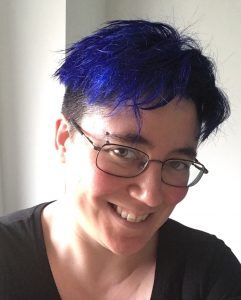 BIO: Juliet Kemp (they/them) is a queer, non-binary, writer. They live in London by the river, with their partners, kid, and dog. Their most recent book, The City Revealed, the final book in the Marek Series, is out now; and their short fiction has appeared in venues including Analog, Uncanny, and Cast of Wonders. When not writing or
BIO: Juliet Kemp (they/them) is a queer, non-binary, writer. They live in London by the river, with their partners, kid, and dog. Their most recent book, The City Revealed, the final book in the Marek Series, is out now; and their short fiction has appeared in venues including Analog, Uncanny, and Cast of Wonders. When not writing or
child-wrangling, Juliet knits, indulges their fountain pen habit, and tries to fit an ever-increasing number of plants into a microscopic back garden. They can be found at https://julietkemp.com, on Twitter as @julietk, or on Mastodon as @juliet@zirk.us

If you’re an author or other fantasy and science fiction creative, and want to do a guest blog post, please check out the guest blog post guidelines. Or if you’re looking for community from other F&SF writers, sign up for the Rambo Academy for Wayward Writers Critclub!
February 23, 2023
It’s All About the Algorithms: My Take on AI Art
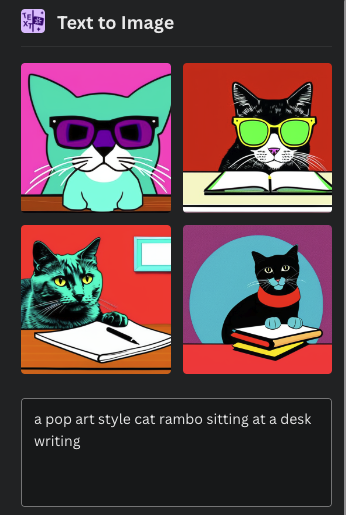 A day that I’ve been saying would arrive for about twenty years now is starting to loom on the timeline, and it’s taking a lot of smart people by surprise when it shouldn’t have.
A day that I’ve been saying would arrive for about twenty years now is starting to loom on the timeline, and it’s taking a lot of smart people by surprise when it shouldn’t have.
I’m talking about AI (artificial intelligence) creations – art appearing in visual, auditory, and textual forms. Such creations are in the news lately because we’ve hit a point where what they’re creating is pretty sophisticated. Not sophisticated enough though (yet) – Clarkesworld Magazine just stopped taking submissions because of a sudden upsurge in AI-generated stories, none of them actually publishable. But the quality of that prose will improve and already people are talking about how to create systems to distinguish between a submission written by a human writer versus a machine-generated one.
Speaking as a former Microsoft employee and long-time technologist, I’m utterly unsurprised. In 2005, I wrote “Zeppelin Follies,” a story about a future “writer.” (You can find the story in my collection Near + Far if you want to read it in its entirety.) Here’s a section:
I forced a smile and patted Fitz’s shoulder. “Be ye of good cheer,” I said. “I think I’ve got that dialogue problem I was having licked.”
Fitz, as I well knew, hated getting drawn into the technicalities, so when I started to explain how reducing the adverbial modifier minimum downwards had tautened the syntactical delivery, he backed out pretty fast. I spent a few hours testing it out, and was pleased with the results. 90% of writing is putting together the formulas, so once I had this one, and a slight problem with the scenery equivalence parameters solved, I’d be sitting pretty, ready to generate a manuscript to hand over to Mikka the editor. Around three, I took a break and went out to sit in the Plaza.
In “Zeppelin Follies,” the writers don’t write. Instead they create the algorithms used to generate their fiction. Will there actually be a point where AIs can generate prose sufficiently adept to construct something that’s an entertaining read? Absolutely, and I would suspect that point is much closer than current writers would like to admit.
But I think the question that most people are deluding themselves about is this: will AI art reach the point where it touches the human soul, the way a Georgia O’Keefe painting can make you stand and stare or the way an Ursula K. Le Guin can make you stop and think, and perhaps even copy it into your notebook to ponder over later? I believe it will, because the consuming human soul remains a constant in that equation, and it doesn’t require another, second soul to be involved in creating the thing we’re appreciating: we can pause for a sunset, for a scrap of birdsong, or to admire the Fibonacci curve inside a conch shell. The experience of the aesthetic depends on the viewer perhaps more than the origin of the viewed.
We would like to think that there is something inside ourselves that recognizes “authenticity,” a word that is a little nebulous. What makes the words coming out of a biological entity’s mouth “authentic” in a way something created mechanically is not? Is it the intent behind the creation? Or something else? We would like to believe that we are more than biological machines, whose actions are on some level as predictable as those of the mechanical ones. We move in a cloud of delusion, in fact, thinking ourselves unique in this universe.
As far as the consumption of what is produced by machines versus what is produced by human hands goes, there are things we buy to use, and there are things we buy to enjoy. We usually don’t worry about the “authenticity” of the dishes we eat out of, but at a certain economic level, we may worry about it as a status symbol, a way to display affluence by using handmade rather than mass manufactured goods. And I don’t know that most people worry too much about the authenticity of what they enjoy, unless they are a connoisseur of it.
I used romance writing as my example in “Zeppelin Follies,” because romances are notoriously formulaic. But the truth is that every genre has its tropes, and that’s something that an AI can use.
Some artists have stopped putting work up online in order to keep it from being fed to artificial intelligences to use. I don’t know that will work all that well, but it’s worth thinking about. But art is also meant to be seen, music to be listened to, text to be read, and we cannot make it so humans are the only ones seeing, listening, and reading.
I think that one way writers will be able to survive a while is by holding onto the overarching ideas of their properties, and the things that make them distinctive and enjoyable. This is one reason why I plan to keep writing books about bioship You Sexy Thing and its crew, because I hold the rights to its world and character. But will AIs create new properties, new worlds? Beyond question, although they will be made of the fragments of other properties, recombined and reworked. Which is, I would argue, on some level what literature is about, replying to the stories that have come before.
Which makes me ask – will an AI be able to look, for example, at Chaucer’s Canterbury Tales and come up with something that is not a reworking, but an original thing that speaks to the Tales? That I’m not sure of. But I’m definitely looking forward to seeing what happens when one tries.
February 22, 2023
Creative AI vs. Creative Humanity: Guest Post by Laurence Raphael Brothers
AI is coming for your jobs, creatives! Or… it will be, eventually. Not this year. But coming soon.
Introduction
The last two years have seen surprising and indeed almost shocking advances in AI creative work. Image-generators like Dall-E, Midjourney, and Stable Diffusion that work from text prompts using diffusion models are capable of some amazingly high quality work at times, though admittedly their understanding(1) of fingers still leaves something to be desired. The even more astonishing ChatGPT can sometimes not just hold conversations that pass the Turing Test, but can also create working computer programs, compose poetry, and also write coherent short stories, apparently from scratch.
Some may reasonably argue the work of such AI systems isn’t creative at all, but is a mere regurgitation or combination of human efforts compiled from its training sets. But on the other hand, much of human art is based on pastiche and emulation, not to mention plagiarism, and both writers and artists have to spend years of training learning the techniques passed on by their instructors.
The State of the Art
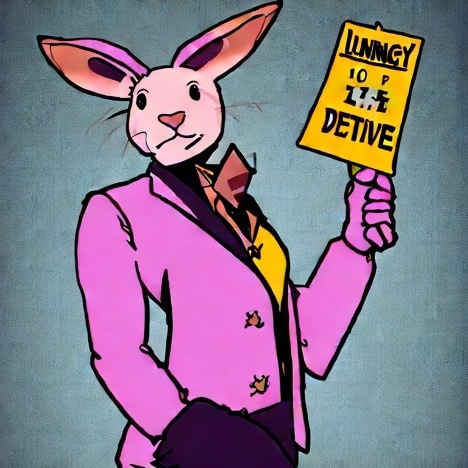
Caption: Protagonist Bunny Häschen from my novel in progress. Generated by Stable Diffusion 2.1 using the text prompt “intersex bunny detective”. A generally rather appealing caricature, but note the odd left hand, the characteristic nonsense characters in the sign, the content oddity of them holding a sign at all, and the mysterious flap rising out of their cravat.
Source: Stable Diffusion
Recent developments are truly astonishing given previous struggles to get AI systems to create art, prose, and other works. It’s now possible to type a few words and get some art back in a minute that might have taken a human hours or even days to produce from scratch. The quality of the AI-generated art is quite variable; from one request to another you might get back commercially usable material or you might get worthless trash. But even considering that you may have to make quite a number of requests of the system to obtain a usable image, the results are still much faster and cheaper than using a human artist for the equivalent level of work.
It’s arguable that if created by a human, these AI-generated images would sometimes be direct plagiarism. Even when not clearly a direct copy of an existing work, it’s often the case that the AI system builders failed to obtain artist permission to incorporate their work into the system’s training data. The legal consequences of this failure will work themselves out in the courts, but for now there’s nothing stopping people from making use of these tools.
At present, complete high-quality AI art is generally unobtainable no matter how much time is taken playing with prompts, but on the one hand, commercial-grade art is often quite acceptable, and on the other hand, by using the AI’s art as a basis, a skilled digital artist can create a high-quality composite of human and AI art much more quickly than working from scratch. This, for example, is what Tor did with Christopher Paolini’s recent book cover.
In the world of prose, with suitable guidance ChatGPT can generate a coherent and consistent story, but not one that’s very high quality. Without substantial revision, the current quality of such text is typically mediocre, but at present it’s not inconceivable for some exceptional AI-generated story to make it past a slush reader’s quality threshold and at least be held for review. Quite the achievement considering the high level of competition many magazines impose on contributors. This is already motivating many AI-generated submissions, though it’s unclear if they are meant for prestige and profit for their pseudonymous submitters or to count coup. Clarkesworld, for example, has reported a recent spike in AI submissions despite their guidelines to the contrary.
The Future of the Art
Because these recent developments in AI art generation have seemed to come almost from nowhere, it’s hard to say how rapidly they will improve to match or even exceed human capabilities. We should keep in mind that autonomous cars were expected to be widely available by now on the basis of work done in the 2010s, and yet after a promising beginning, only slow progress has been made and such vehicles are still unsafe on real-world roads.
On the other hand, given the eagerness of many extremely well-funded tech groups to work in this area, including not just OpenAI but Microsoft and Google among others, it’s reasonable to expect further progress up to a point. What’s the limit? For current system architectures, I expect that limit is based on these systems’ lack of explicit real-world knowledge. Just as ChatGPT is capable of absolutely authoritative but totally incorrect and easily refutable statements, these systems will be hamstrung by the inability to reason until such capabilities are combined with their generative models.
Let’s establish three bars:
Acceptable low-grade commercial art. The kind of graphic art that creative freelancers currently make to order for ad campaigns and other commercial applications without much funding, but which will still pay their rent. Equivalent prose would be acceptable for publication in some token and semipro magazines and for routine copywriting assignments.Acceptable high-grade commercial art. Commercial art produced for highly funded campaigns by major agencies and design firms, or prose and content that can be published in the better magazines and journals.Superior-to-human fine art. Masterpieces that would displace human efforts from galleries and museums and bookstore racks and win awards if AI and humans competed on a level playing field.We’re currently just entering stage 1 for certain applications. This means that soon some semipro freelancers may experience serious competition from AI systems, and after a while some agencies and design firms may reduce their staff because their routine low-end work can be done by machine. There will still be plenty of human work involved in revising, incorporating, or compositing AI work into larger and higher quality artistic achievements, but the amount of human touch in the overall process will diminish.
At stage 2, entire industries will be turned upside down and the effects will shake up whole economies. For example, design firms may no longer require creatives, or else the few creatives they retain will largely be employed managing requests to AI systems. There will be no more need for human touch in photoshopping or otherwise compositing AI art with human-created elements as in stage 1; the AI will do all the work on demand. (Note that while some very high quality AI art has been created already, it typically requires considerable manual effort from a human to achieve such a level).
The good news is that my average-case guess for stage 2 is at least ten years, and it may well be generations before this level is achieved. The bad news is that I could be wrong and it could be next year. I was shocked by ChatGPT’s capabilities in 2022 after years of crappy chat bots that wouldn’t fool Turing for a minute, and so I may easily be wrong again. Still, I do think that without explicit real-world knowledge and reasoning abilities these tools will be unable to really excel for quite some time. At present no one has any idea how to give a generative AI system that kind of understanding.
At stage 3, humans start wondering why they should even bother creating art, especially if such superior work can be routinely requested of AI systems by anyone without incurring much cost.
Similar considerations apply for stage 3, which to my mind requires Artificial General Intelligence to achieve. Such a system is not absolutely out of the question. We just don’t know how to build one today, nor do we even have a good idea on a direction to follow to achieve such a goal.
Still, even stage 1 is problematic enough for human creatives. I’d guess full stage 1 will be achieved within five years, and whatever the courts decide about existing systems and their theft of artist work without permission, one way or another AI-generated art will become ubiquitous for inexpensive applications.
(1) Indeed, the reason that such systems don’t know how to draw fingers properly is they don’t even understand the concept of fingers. These systems don’t have old-fashioned knowledge bases that contain explicit facts or relations. The appearance of a hand is emergent from mysterious mathematical features derived automatically from the digitized training set. Discrete counts of things that characteristically appear in fixed numbers in nature but are often hidden from view in individual images can be problematic for such systems. Human images very frequently show two clearly identifiable arms and legs and so AI images get these right more often than not (not always however!) but hands in photographs less frequently show all five fingers clearly, and so generated images often don’t do so either.
BIO: Laurence Raphael Brothers is a writer and a technologist with five patents and a background in AI and Internet R&D. He has published over 50 short stories in such magazines as Nature, PodCastle, and Galaxy’s Edge. His noir urban fantasy novellas The Demons of Wall Street, The Demons of the Square Mile, and The Demons of Chiyoda are available from Mirror World Publishing, while his new standalone novel The World’s Shattered Shell has just been published by Water Dragon.
Pronouns: he/him.
Twitter: @lbrothers.
Mastodon: @laurence@petrous.vislae.town.
Website: https://laurencebrothers.com.
January 17, 2023
Patreon Revamp, AKA Why You Should Join If You Haven’t Already
January 16, 2023
Guest Post: Liz Danforth on AI Art
Note: This originally appeared on Liz’s Patreon, which you can find here, and which I highly recommend.
Scrying the Future
The world will continue to argue the benefits, ethics, problems, and controversies about AI art and writing long past my lifetime, even if I live to be 100 years old. So I write this as a scene in media res, one drop in an ocean of ink and pixels already washing over us.
Please take it as a given that my opinions and understandings written here will also change over time, as I keep learning. And fair warning: this is a longform essay with no easy TLDR. I hope you’ll stick with me.
What the AI..?
Let’s start with some descriptive definitions. (They are personal, completely off-the-cuff, and probably wildly inaccurate by several metrics.) When I refer to “AI art” here, I am referring to the artificial intelligence deep-learning engines capable of building artistic images from human-generated natural language prompts.
In simpler English, you can ask the computer to “draw me a picture of a teddy bear kissing a unicorn,” and you’ll get one, or at least something like it.

It is likely you’ve heard of DALL-E 2 by now, or Lensa, or maybe MidJourney or Fotor, or one of the others. This teddy-bear/unicorn is from DALL-E 2 and you could find images like this on any kiddy-cutsie Hallmark card. In theory, these exact images never existed until I asked for it. If you gave the same prompt, you’d get different pictures.
Only #3 actually matches closely what I asked for. But then, my query was as simplistic as the results, and I did no selection or editing. Because I really don’t know how to use this thing yet.
I can generate images, or variations on the same theme based on one I like better than the others. For now, I’m just fine with that (for reasons I will clarify below). Other people are doing amazingly “finished” pure AI-work that I would be glad to call my own (as if I could even hope to paint such a thing).

And for heaven’s sake, Steve Colbert’s graphics team used MidJourney to create a topical take on Kevin McCarthy’s chaotic election as Speaker of the House. (Go to minute 6 if you want to see the segment in that link.) I feel certain that wasn’t a single iteration of the prompt, but one that needed to be revised to get the final image. And no, I couldn’t have painted this either.

Do I Feel Threatened?
Yes and no. It’s the wrong question, albeit the obvious one.
Do I think this changes the world? Probably. Everyone literate enough to string words together, and/or upload a photo, and have the patience to learn the interface, can bring their visions alive. That’s like the invention of the alphabet. Coupled with basic literacy, anyone can become be a poet, a bookkeeper, a storyteller, a professional liar or prophet. Anyone can hear the words of the dead, or those who never lived (but someone wished they would have). Quality will vary, but the alphabet means that it can be done.
The controversies about AI art have only just begun. Artists are being accused of making traditional art that looks like an AI did it. Others are aggrieved that the AI is sampling their painfully-acquired skills to make art that looks like theirs (but isn’t).

With these as samples, I’m not going to be out of work any time soon… not if the person making the commission wants the work to actually look like mine. Could they be refined to be more like mine? Probably.
But again — that’s not the right question about all this.
And in truth, I’m still formulating what the right questions are. This is evolving as fast, or faster, than covid’s mutations, and will continue to do so. We must get used to both realities.
What Has Gone Before
Backstory: 2-3 decades ago, a stranger learned I was an fantasy artist. “You’ll be out of a job soon. Anyone can use Photoshop on photographs to make what you do cheaper and faster, and it’ll look more real,” said he. I asserted that until one could take a snapshot of a dragon, I’d have work for the foreseeable future. But clearly he thought Photoshop would change everything.
Well… in many ways, it did. Nowadays you don’t need a photo of a dragon: a pangolin + a lizard + bat can be cobbled together and it can look damn good. A skilled Photoshop artist can produce breathtakingly beautiful, thoroughly original artworks than only an expert can see are not traditionally-created. And traditionally-created art is not sufficient in and of itself (except in limited circumstances) to make it more desirable than slick, polished, highly-finished Photoshop work. Someone in Photoshop can work faster than I can, and can make changes requested by the art director in a fraction of the time … if I even CAN make those changes at all. I am fading away into being a buggywhip maker, if you will… a perfectly good skill, hard-won, but no longer required or practical.
This is Where I Am Today
Nevertheless, I do use Photoshop as one of my tools. To date, I have never used it as my exclusive medium, but I have used it as part of many projects. For starters, I use it every time I post a picture in Patreon.
Recently, Steve Jackson’s two-sided counters were easiest done once as whole items (urns, gazebos, gazing balls) fully drawn as traditional ink drawings… and once more as their broken versions, Photoshopping in the cracks (usually drawn with ink on paper) and wiping out extraneous bits. The whole-item drawings physicially exist. The broken ones are entirely digital except for random ink lines on a separate sheet of paper that mean nothing by themselves.

The SJG flower elemental became a full color Elemental Token for an entirely different game (used with Steve’s permission). All the color work and layout was Photoshop.
Does this make me less an artist? I’d like to think not. I am simply using the tools that suit my purposes.
Here is My Present View of AI Technology…
… for myself. I see it as an interesting tool with curious potentials. I cannot speak for anyone else, artist or proto-artist, ethicist, or pearl-clutching critic decrying the fall of Western Civilization. As I am using it right now, I am using it … occasionally … as another tool, an idea-generator, and a way to jumpstart my creative brain out of lazily just doing the same-old same-old. Here are examples I’ve done in the last year. Forgive me if you’ve seen some of these here on Patreon before now.
First Use
Tasked with a 4-card set on the back of some Artist Proof cards, I was asked to do something “with underwater monsters.” Not the most detailed description, although I appreciated the latitude it gave me. But I lacked any urgent inspiration.
However, I had run into MidJourney (the one Colbert’s people used) early last year. I thought “I wonder what MidJourney thinks ‘underwater monsters’ look like?”
If I saved those first images, I can’t find them now. But I asked for “underwater monsters” and — like the images above — got a lot of silliness. But one I really liked was an asymmetrical critter with multiple orange eyes and long kelpy toes. I used other art references as well, like photos I’d taken from the Atlanta Aquarium. I referenced a book cover of 20,000 Leagues Beneath the Sea, for its depiction of sun beams coming into deep water.
I made this:

I don’t think it would ever have occurred to me, on my own, to make that critter with the orange eyes. The MidJourney prompt jolted my brain, and I ran with it. Inspiration came from many places for this piece, which is sometimes given as the very description of creativity, after all: to take things that were not linked before, and to put them together.
And there’s the rub. That’s precisely what the AI engines are doing, assembling images out of the “inspiration” derived from its knowledge of however-many-kajillion examples of art loaded onto the internet.
We will be having conversations about the ways that is and is not different for… a very long time.
Let’s Have Another Example
Another card-art commission asked me to revisit the shaman-seer from the “Portent” Magic card. The client asked him to be peering into a crystal ball, something like a palantir (the “gazing balls” used by Sauron and Saruman, if you will). Below you can see the original card, and the final result.
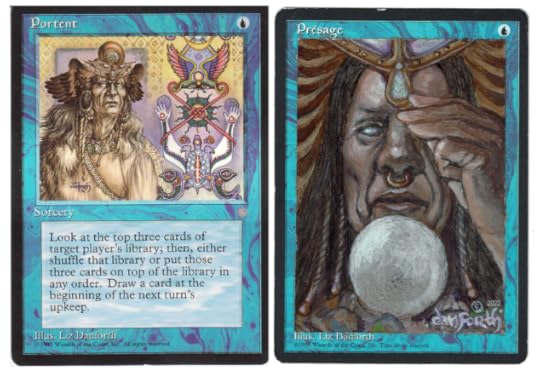
The original card art could be considered “derivative” in many ways, or simply full of creative recombination with iconography of many and varied ancient cultures. (I often jest that I didn’t want to steal any one people’s patrimony so I took from all of them… at least, all that I could fit into the vision.)
For the original shaman, I wanted to harken back to the sepia-tone photographs of indigenous North American people taken by Edward Curtis in late 1800’s and early 1900’s. For the commission, I wanted something a bit like Curtis again but different, while still including recognizable features of the earlier card image.
In this case, I turned to DALL-E and fed it this prompt: “a very elderly blind indigenous man who is a seer, peering into a crystal ball like a palantir. There are bird images in the picture, and items of copper and turquoise.” This is what DALL-E offered me:

Most are terrible but I kinda liked the far one. You can see the elements I picked up: the man faces full-front, his raised hand obscures one eye with the little finger tucked up just so, and there is “stuff” on the table.
I had to fix his hand. (Why DALL-E thinks all these seers should have only three fingers is curious to me). I brought in a large separate globe because the black marble was completely unsatisfactory. His visible eye wasn’t cataract-blind; I made it so. I added more elements from the card painting: his copper-and-bluestone headpiece, the feathered “wings” to each side (abstracted), his nose ring, his braids wrapped with copper end-beads.
I was and am quite pleased with the final result, as is the client. Should we be? I feel like DALL-E pointed me to an idea that I morphed to suit myself. In what ways is that different from the art director’s inch-thick file of written descriptions and existing drawings/paintings I had to refer to (and match stylistically) when making one of my last Magic cards? Staff, land, costumes all had to match exactly.

Last Example
This client asked me to revisit “Zur’s Weirding,” one of my stranger Magic cards, onto a four-card set of artist proofs. Our email conversation poked at a number of options and suggestions, batted back and forth.
In the end, I would make one picture with three iterations of Zur rockin’ the three colors of the card’s mechanics in shapes to suggest the typical representations seen in those colors: Zur as a blue mage, as a black lich-ghoul-zombie, and as a white priest-cleric. We also wanted to pick up on Pete Venters’ depiction of him as the supercrazy “Zur the Enchanter” — which I felt fine doing because I’d spoken to Pete about it, and knew he was trying to echo my depiction in his own work while also making it his own. I knew he wouldn’t mind if I returned the favor.
Here’s my original card image, and Pete’s when used on a playmat:

The commission had a lot of elements to include, and that was good. However, I was afraid of making the three-man pose too conventional. I decided to ask DALL-E if there was an interesting way to position three figures on the page, and gave it the prompt “Three men standing together: a cleric, a magician, and a lich. Fantasy setting, photorealistic, moody lighting.”

Again, the results were not to spec, but I liked bits of the second one: the paunch on the fellow on the left, and his big book… the upraised hand on the fellow on the right, and the way his cloak fell. The backlighting.
Here is the final result.
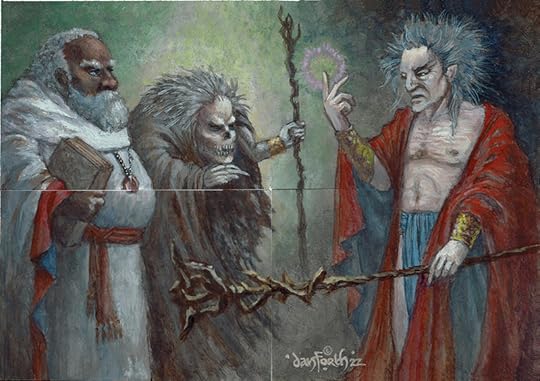
What was perhaps less intentional is that I’d just watched Netflix’s The Sandman. So Magician Zur has something of Morpheus’ hair, and the cleric is black because I’d been primed by the show to think in more than one skin color. Oh: and the ruby.
Inspiration, Influence, and Plagarism
Inspiration comes from everywhere. In none of the AI-adjacent pieces did I copy the prompts directly. I used them the same way I use photographs, or a cloudshape I saw the evening before, or the color scheme of a book with an entirely different cover than the art I was working on. Showing you these pieces with their elements exposed feels almost as deadly as a stage magician showing you how their tricks are done. I hope you won’t think the less of me for it…
…because I feel strongly that copying and plagarism are real, and to be assiduously avoided. If you can spot what was taken from elsewhere, whole and entire, plonked down in the middle of one’s “new” work? That’s a problem. Copyright law today is badly flawed, but it exists for good reasons, and fair use confuses many. (This video is priceless but will make you twitch as you learn.)
Are these things — plagarism and copying — just the evil end of a sliding scale? At the other end is… what? Creative output 100% uninfluenced by anything that has come before?
I doubt it exists. I recall a science fiction story (whose title or author I cannot recall for the life of me), dating from my childhood. Scientists experiment with a musically creative child raised in isolation, exposed to absolutely no existing music whatsoever so they might find out what “pure” musical creativity truly was. The kid was outed after he got hold of a Bach fugue, and (thus inspired by a novelty he hadn’t invented independently) began incorporating fugues into his music. To the researcher, his purity was “spoiled,” the experiment ruined.
I learned to ink copying Aubrey Beardsley and Alphonse Mucha; my linework still has an Art Nouveau flavor to it. My designs and preferred poses often carry that sensuousness and framing; the way I create costume and drape cloth shows it. There were a plethora of other influences, but that’s one thick taproot.
If influence is plagarism, no artist can escape it. We learn to see, to think, to admire, to depict, to emulate, to pose, to paint, to draw by looking at the world and all — ALL — it has to offer our eyes and our imagination. And we put it together in new ways the same as writers make new stories and even new words using the various alphabets of the world, ancient and modern, even as they are retreading old words again and again.
So perhaps, in part, it is just a question of including enough different bits from enough different places, consciously or unconsciously: Only be sure always to call it please “research.” (Cue Tom Lehrer’s Lobachevsky.)
Just my drop of pixel-ink in the ocean of conversation we can and will surely have about this topic for many years to come. I am skipping over many related topics. I come away with more questions than answers. And I am okay with that.
— Liz
CREDITS: Jason M. Allen’s “Théâtre D’opéra Spatial” image taken from https://www.cnn.com/2022/09/03/tech/a...
If you’re an author or other fantasy and science fiction creative, and want to do a guest blog post, please check out the guest blog post guidelines. Or if you’re looking for community from other F&SF writers, check out the Rambo Academy for Wayward Writers’ virtual campus, with classes, weekly Zoom events, and a critique group.!
January 5, 2023
Social Media Chat: Twittering in 2023
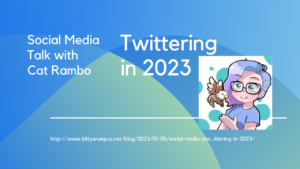 Hello! One new thing I’m introducing for 2023 is a monthly social media chat in which I’ll catch you up with the ever-changing social media landscape.
Hello! One new thing I’m introducing for 2023 is a monthly social media chat in which I’ll catch you up with the ever-changing social media landscape.
In the first one, I’ll talk about Twitter, places to migrate to if you’re leaving Twitter, tools that can make that migration easier, and why you might want to establish a presence on some even if you’re sticking with Twitter.
Date: Saturday, January 7, 10 AM Eastern time via Zoom. It will be recorded and will go up later on the YouTube channel.
Cost: free for Patreon supporters; $5 and up patrons will be able to submit questions in advance
$10 for non-patrons
To reserve a slot, mail me at cat@kittywumpus.net, and if not a Patreon supporter or Rambo campus member, let me know how you’d like to pay.
December 25, 2022
Annual Holiday Sale: On-Demand Classes
 Hello! Time is slipping away on 2022, and I’m running the annual holiday sale on on-demand classes, where they are $5 each. Or you can grab all 21 classes on offer for $100. This offer is only good through January 2, 2023! (Some classes are going up in price next year, so snag them now!)
Hello! Time is slipping away on 2022, and I’m running the annual holiday sale on on-demand classes, where they are $5 each. Or you can grab all 21 classes on offer for $100. This offer is only good through January 2, 2023! (Some classes are going up in price next year, so snag them now!)
Here’s the list of on-demand classes, all of which are $5 if you access them through the link in this list. This is how the on-demand school breaks even each year, so please spread the word and feel free to forward this mail to anyone who might be interested.
The Basics: A Toolkit for Writing FictionCharacter Building Workshop: How to Create Characters that Keep a Reader Glued to the PageDescription and Delivering Information for Genre Writers Different Kinds of Love: Writing Non-Romantic Relationships Dunking Your Reader in the Details: Three Toolsets for Creating Immersive Worlds Epistolary Fiction: Writing Fiction as a Series of Documents Getting Your Pod On: Podcasting for Writers Hex Engines and Spell Slingers: How to Write Steampunk and Weird Western Historical Research for Writers Literary Techniques for Genre Writers: How to Use Literary Techniques to Take Your Writing to the Next LevelMoving from Idea to Draft: Different Kinds of Story Inspiration and What to Do with ThemPower of Words: Everything Fantasy and Science Fiction Writers Need to Know about Linguistics at the World-building and Prose Level Principles for Pantsers: Navigation Tips for the Unguided Journey Reading to an Audience: How to Read Your Work Aloud to Other People and Have Them Enjoy ItRewriting, Revising, and Fine-tuning Your FictionSEO Basics for Writers: Using Search Engine Optimization to Market Your Books To Space Opera and Beyond with Ann Leckie Twenty Types of Terror: Horror Subgenres and How to Generate Ideas for Them Writing Flash Fiction: How to Write and Sell Flash Fiction Writing Interactive Fiction Writing Your Way into Your Novel: How to Find Your Path by Putting Words Down Bundle of all 21 classes for $100.December 15, 2022
If You’re Shopping for Gifts that Don’t Need Shipping for a Writer
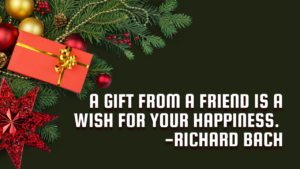 Are you holiday shopping for a writer? The Rambo Academy for Wayward Writers offers classes and community for writers ranging from those just starting out to published, award-winning writers. The virtual campus includes a moderated Discord server, a critique exchange group, and monthly Zoom events including special guests, discussion groups, and writing games. You can find out more about the levels here.
Are you holiday shopping for a writer? The Rambo Academy for Wayward Writers offers classes and community for writers ranging from those just starting out to published, award-winning writers. The virtual campus includes a moderated Discord server, a critique exchange group, and monthly Zoom events including special guests, discussion groups, and writing games. You can find out more about the levels here.
If you know someone who would like membership in the Rambo Academy for Wayward Writers community, a story edit, a coaching session, a class, or maybe even a mix of all of the above, it’s easy to buy them a gift certificate, which can be printed out and stuck in a card or put under the tree.
You can buy a specific dollar amount or you can specify coaching sessions, edits, or classes.
Sample costs are:
A year’s membership to the Discord community $50A 30 minute coaching session $50A story edit, $50 for first 5000 words, $10 for every additional 1000 words.Online workshops range $59-$99; the full list through March 2023 is here.To order, mail me with the details of what you’d like to buy, who it’s for, and how you’d like to pay (PayPal, Venmo, check, or some other mechanism).





